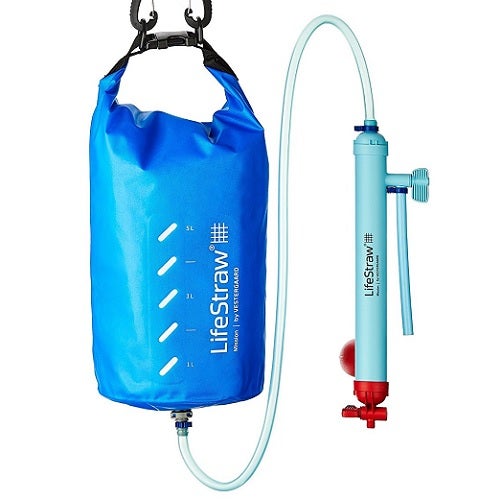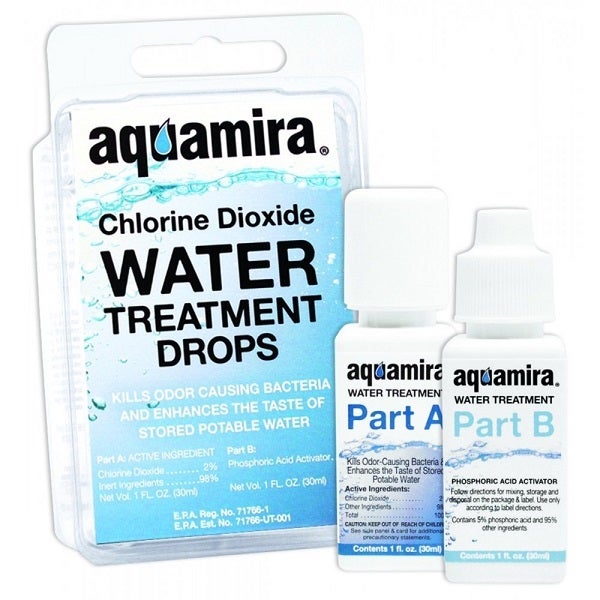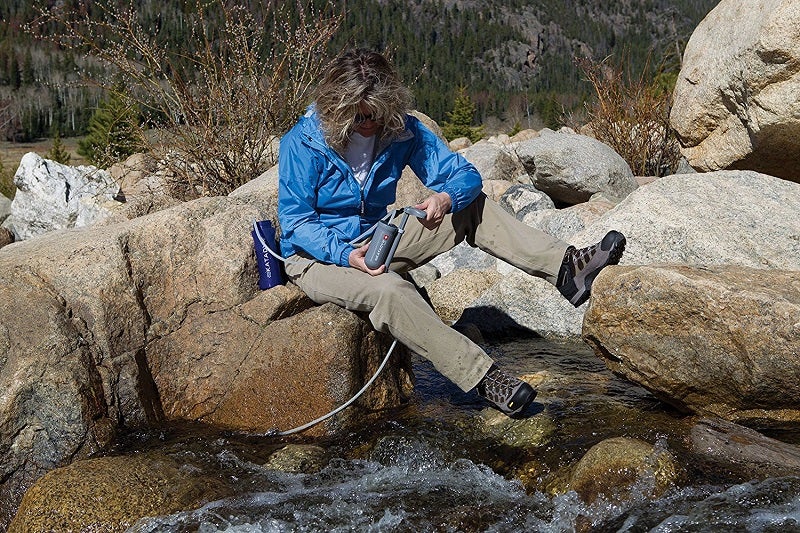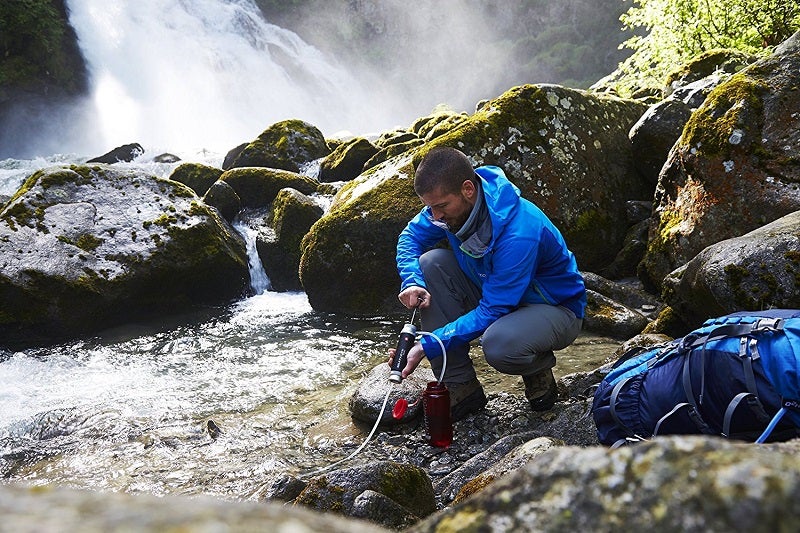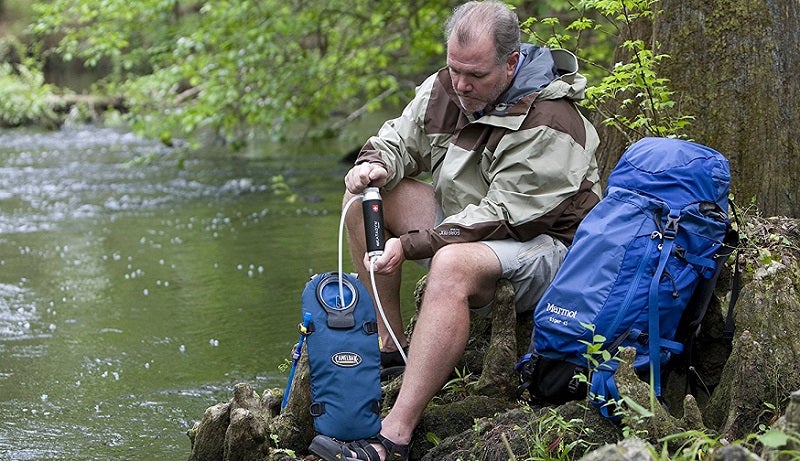
Our Editors independently research, test, and rate what we feel are the best products. We use affiliate links and may receive a small commission on purchases.
In order to safely and effectively travel in the backcountry it’s critical to avoid illness. One potential source of infection is through water-borne pathogens and there exist many methods of water purification. One of these methods is a backpacking water filter – a physical filtration system whereby pathogens are filtered out of the water using mechanical water pressure and a filter.
So what is the best backpacking water filter?
There are many methods of effective water purification such as boiling, chemical, UV, or physical filtration. Which method you ultimately choose is a function of many considerations.
The Best Backpacking Water Filters
For more of my top gear recommendations, have a look through these popular Outside Pursuits guide links: Backpacking Firestarters, Backpacking Stoves, GPS Hiking Watches.
Quick Answer: The 7 Best Rated Backpacking Water Filters
- LifeStraw Mission Water Purifier
- Katadyn Vario Microfilter
- Katadyn Hiker Microfilter Water Filter
- MSR MiniWorks EX Microfilter Water Filter
- Sawyer Products MINI Water Filtration System
- SteriPen Ultra Handheld Water Purifier
- Aquimira Chemical Treatment
Our guide and comparison table of the top rated backpacking water filters will help you choose the right one for you.
Backpacking Water Filter Reviews
#1 LifeStraw Mission Gravity-Fed Water Purifier
- Type: Gravity Fed
- Treatment Method: Hollow membrane water purifier
- Flow Rate: 9-12 liters per hour
- Lifetime Use: 4,755 Gallons
There are so many good things to say about this water filter system that it’s hard to know where to start…
Lifestraw is probably one of the most recognized names in water filtration and the LifeStraw Mission Water Purifier is one of the best options for backpackers and campers.
Ease of use and simplicity are top selling factors. Simple, fill a bag with water, attach the filter and the hollow membrane water filter gives you water that has 99.9999% of bacteria, protozoa and viruses removed from the water.
Viola! Clean clear water, no chemicals or anything else needed.
Gravity filters and pressure filters have been around for ages and the Lifestraw Mission takes the technology to a new level.
To clean it out you just use the integrated backwash bulb to clean out particulates and debris so you can use it again.
The filter is rated for up almost 5,000 gallons of filtered water but it is pretty doubtful you’re likely to test that – that’s a whole lot of water!
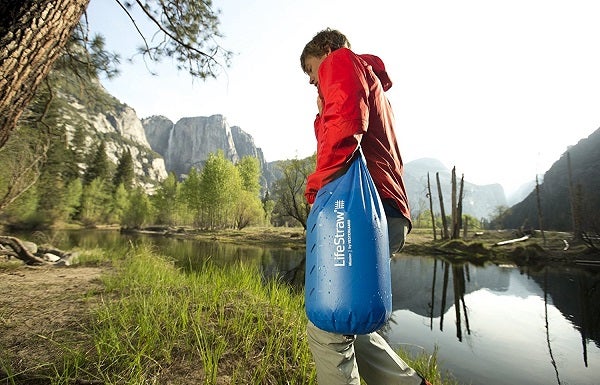
These filters have exploded in popularity and you’re guaranteed to find hundreds of rave reviews and other users on the trail the next time you’re out backpacking and since it can filter a lot of water it’s also one of the best camping water filters.
It’s available in two sizes, a 5 liter and a 12 liter for when you have a group of people.
#2 Katadyn Vario Water Filter
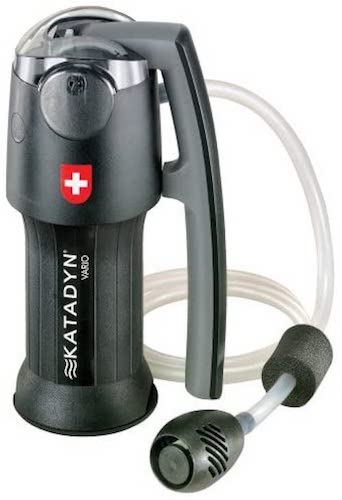
- Type: Pump
- Treatment Method: Silver impregnated ceramic element, carbon core
- Flow Rate: 1-2 quart per minute
- Lifetime Use: 13,000 Gallons
The Vario Microfilter combines efficiency with a sleek design.
The technology consists of three filter levels: a high-performance glass fiber filter, a ceramic pre-filter that can be adjusted to the cloudiness of the water, and active charcoal for eliminating odors.
Its replaceable carbon core reduces chemicals, pesticides and any sort of bad taste in your water.
With a cleanable ceramic disc and a glass-fiber microfilter, this model quickly removes waterborne bacteria and can be easily cleaned to ensure its longevity.
It can produce up to two quarts per minute in ‘fast flow’ mode and one quart per minute in ‘longer life’ mode – so you can choose between speed and endurance.
Weighing in at a mere 15 oz, this is an ultra-lightweight microfilter that can be transported nearly anywhere. Its height of 6 inches makes it the perfect size for a backpack.
This is the best option for those who need portability as well as quality and speed.
#3 Katadyn Hiker Microfilter Water Filter
- Type: Pump
- Treatment Method: Micron glassfiber filter with activated carbon
- Flow Rate: 1 Quart per minute
- Lifetime Use: 200 Gallons
The first water filter I ever purchased and used was a Katadyn Hiker Pro (effectively the same filter) and it lasted a few years before the output nipple broke off when I attempted to remove the hose.
As far as I can tell, this was a one-off incident and the filter by and large is quite reliable. That being said, the filter is entirely plastic and more fragile than, perhaps, other comparable filters.
One major upside is the low initial cost to buy as well as widely available and inexpensive replacement filters. This portable water purifier does a good job while avoiding excessive clogging and cleans easily.
To clean the filter, you just need to unscrew the filter element, rinse it out, and set it to dry (or bleach it if needed). A single circlip holds the pump arm on to the body of the filter and you’ll need to disassemble, clean, and lube it after each trip.
If you can find the filter on sale or at a discount, it’s definitely one of the best backpacking water purifiers.
#4 MSR MiniWorks EX Microfilter Water Filter
- Type: Pump
- Treatment Method: Carbon/ceramic element
- Flow Rate: 1 Quart per minute
- Lifetime Use: 500 Gallons
Another ceramic element filter, this time from MSR. I’ve used this filter before and had mixed results – it’s one of the ones that tend to clog quickly.
However, if you’re using it correctly and filtering water that’s not too full of sediment then it’s a great water filtration system. This one operates using a lever arm instead of a direct pump handle in a vertical fashion.
One cool feature is that the filter can screw directly on to a Nalgene wide mouth bottle or a Dromedary (Drom) water bag for easy filling.
Video: Overview of the MSR Miniworks.
This is a feature I fail to use, however, as my water bottle (Platy Plus Bottles) doesn’t fit the adapter. If you’re a heavy Nalgene die-hard, then this might be a good feature for you.
It’s pretty easy to disassemble and clean and, once again, you’ll have to scrub the ceramic filter on occasion to clean off the filtered sediment and debris.
At a much lower price and with more affordable replacement cartridges than the Katadyn Pocket, this filter might be an economical choice. Be aware, however, that it is a less durable all-plastic construction but being very lightweight it might be the best hiking water filter.
#5 Sawyer Products Mini Water Filter
- Type: Squeeze
- Treatment Method: Membrane inline filter
- Flow Rate: 1 Quart per minute
- Lifetime Use: 100,000 Gallons
When you need a drop-dead simple and effective water filter for your backpacking trips the Sawyer Mini is perfect. It’s been used on the trail by hikers for years and is a trusted solution.
When you’re ready for a drink just fill the Sawyer squeeze pouch with water from your source and screw it on the filter and either drink directly from it or squeeze the water out into a water bottle.
Doesn’t get any easier.
The filter is rated for 100,000 gallons and removes 99.99999% of harmful bacteria like salmonella and E.coli. The Sawyer Mini will work with water that has a lot of sediment but it will clog up much faster and require backwashing the filter.
The Mini weighs only a few ounces so it’s perfect for ultralight backpackers but is not just for the backcountry.
Use it anywhere that you don’t trust the water. It will also work with hydration packs as an inline filter, you just need an optional adapter.
#6 SteriPen Ultra Handheld Water Purifier
- Type: Purifier
- Treatment Method: Ultraviolet light
- Flow Rate: 22 oz per minute
- Lifetime Use: 8,000 uses
Next on our list is the SteriPen Ultra Handheld Water Purifier. This is a bit different from our other options – it’s not exactly a water filtration system, although it performs the same function.
This is actually a steri-pen, which uses an ultra-violet lamp to destroy over 99.9% of bacteria, viruses and protozoa.
Weighing in at 2.6 ounces, this purifier is small but mighty. Though it can fit in your pocket, it is capable of cleansing 1.0L of water in a mere 90 seconds!
Its easy-to-use, one-button operation offers 8,000 treatments, bringing this product’s lifetime use to 8,000 liters.
It even comes with water-activated sensors which turn on when the pen encounters liquids.
Maintaining this purifier is a breeze – simply charge and recharge it using its conveniently located USB port.
It’s a brilliant option for those who need both portability and performance!
#7 Aquamira Chemical Treatment
- Type: Chemical purifier
- Treatment Method: Chlorine Dioxide
- Flow Rate: N/A
- Lifetime Use: 30 Gallons
While this article is all about physical filters for water purification, I’m going to take a minute to address chemical purification. Various forms of chemical purification exist from Iodine, AquaMira, and bleach.
Chemical purification does nothing to remove physical sediment so if the water is dirty, you’ll be drinking the dirt.
However, chemical purification using chlorine dioxide, when used properly, will kill all pathogens in your water. Advantages include price (for some forms), utility, weight, and bulk.
Chemical purification options can be quite affordable and, while Aquamira water treatment drops will eventually add up to exceed the cost of some filters, the benefits can outweigh.
Personally, after much research, I have chosen to migrate to unscented pure bleach for purification and use this method exclusively (for about the last 3 years).
When done properly bleach is safe to drink (due to dilution) and effective at killing pathogens.
My motivation?
I can pay less than $5 for a gallon of bleach which will purify hundreds of thousands of gallons of water, transfer it into a one ounce dropper bottle weighing mere grams, and have enough purification for weeks on the trail at a time.
Iodine tabs and Aquamira water treatment drops are perfectly safe, commercially manufactured and tested, chemical treatment methods and I used AquaMira for years before switching to bleach. Highly recommend them!
Backpacking Water Filter Comparison Table
| Water Filter | Type | Treatment Method | Flow Rate | Lifetime Use | Rating | |
|---|---|---|---|---|---|---|
| LifeStraw Mission Gravity-Fed Water Purifier | Gravity Fed | Hollow membrane water purifier | 9-12 liters per hour | 4,755 gallons | 4.3 / 5.0 | |
| Katadyn Vario Water Filter | Pump | Silver impregnated ceramic element | 1-2 quarts per minute | 13,000 gallons | 4.2 / 5.0 | |
| Katadyn Hiker Filter | Pump | Micron glassfiber filter with activated carbon | 1 quart per minute | 200 gallons | 4.3 / 5.0 | |
| MSR MiniWorks EX Microfilter | Pump | Carbon/ceramic element | 1 quart per minute | 500 gallons | 4.2 / 5.0 | |
| Sawyer Products Mini Water Filter | Squeeze | Membrane inline filter | 1 quart per minute | 100,000 gallons | 4.6 / 5.0 | |
| SteriPen Ultra Handheld Water Purifier | Purifier | Ultraviolet light | 22 oz per minute | 8,000 uses | 4.6 / 5.0 | |
| Aquamira Chemical Treatment | Chemical | Chlorine Dioxide | N/A | 30 gallons | 4.7 / 5.0 |
How to Choose the Best Backpacking Water Filter
- Size and Weight
- Types of Water Filters
- Replacement Parts
- Filter Pore Size
- Water Considerations
- Filter Element Types
- FAQs About Water Filters & Purifiers
- Conclusion
Size and Weight
For backpacking size and weight definitely matter but they’re not always the end of the story. All else being equal, an intelligent backpacker would choose the smallest and lightest of all options when picking a piece of outdoor gear.
Some of the lightest and smallest options for purification are not filters at all – chemical purification is one of the most compact forms of water purification and UV pens can be quite compact.
Type of Water Filters
Were going to take a look at the 3 methods of water filtering.
Straw
Just like the name you suck the backcountry water through a straw that has a filter. These filters have the advantage of being light and drop dead simple to use.
The drawback?
You cannot filter a large quantity of water to store for later use and as a result, are only useable when you are near a water source.
Pump Filters
Here we can now filter large quantities of water using a mechanical pump to force the water through a filter into a storage container. The advantage is pump filters can quickly filter water but they do require some effort to work the pump!
Gravity
Instead of working a pump, we take advantage of gravity to direct the water through a filter into your storage container. They have the advantage of the ease of use. Just hang the water pouch from a branch and let gravity do the work!
The disadvantage is they are slower since there is no mechanical force pushing the water through the filter. And of course you need somewhere to hang the pouch from!
Replacement Parts
Mechanical filters all have a filtering element which must eventually be replaced. In some cases, the filter and unit are disposable and must be replaced entirely when the filter has met the end of its life span.
In the case of UV purification, batteries must be recharged or replaced. For chemical water treatment, the chemicals themselves will eventually run out.
Filter Pore Size
Pore size, for mechanical water filters, refers to the size of the holes in the filter through which water is squeezed. The idea is to have a pore size smaller than the pathogens you’re filtering yet large enough to permit the passage of just water.
Before purchasing a mechanical filter be sure to review the pore size, usually measured in microns, against the size of the pathogen you wish to filter out. Not all filters can filter out every type of pathogen – surprisingly.
Water Considerations
If you’re heading into areas of stagnant and dirty backcountry water or areas where suspended sediment is extremely high, you’ll have a lot of trouble with mechanical filters.
One of the biggest issues is that the filter will quickly get clogged with dirt, sediment, or suspended particles in the water which get filtered out.
I’ve had filters get clogged so quickly before (in relatively clean water) that I have to clean them after each liter of filtered water. This is a huge pain in the ass and can be a problem even when the filter is used properly. In these cases, pre-filtering the water by straining through a cloth can be helpful.
If all else fails, you may want to consider a purification method which is physically unaffected by sediment such as chemicals.
Filter Element Types
Carbon Elements
Carbon is used in filter elements to neutralize toxic chemicals and compounds. These toxic entities could come from ground leakage, nearby mine tailings, or a power plant upriver.
Carbon in a water filter is surprisingly good at balancing out nasty chemicals that might be in the water. Make sure to use a carbon filter if you suspect chemical contamination.
Sediment Filters
These are usually paper filters or fiber filters of some kind. They have relatively large pore sizes and they’re meant to catch the big gunk like algae, sediment, and floaties. Yes, I know, floaties isn’t a technical term but… too bad.
Sediment filters alone won’t stop the nasty pathogens but they’re a great pre-filter to keep your main filter from clogging up so quick!
Ceramic Filters
These little dudes have insanely tiny holes called pores through which water molecules may pass. Pore sizes can vary, but the smallest pores are just big enough for water but too small for tiny pathogens. Therefore the resulting water is free of pathogens!
Ceramic filters may also have silver in them (that means pricey). These silver lined filters release special ions that help further kill and prevent pathogen buildup on or in the filter itself.
To get the most out of your filter, you probably will need some combination of carbon, sediment, and ceramic elements!
FAQs About Water Filters & Purifiers
Q: What’s the difference between filtration and purification?
A: Great question! While it may seem like splitting hairs, let me help clear this up.
Filtration is the process of drawing water through a porous material to clean it out. Filtration could be straining murky water through a bandana, or forcing water through the microscopic holes in a ceramic filter. Both are technically water filters.
The important thing to remember with filters is that the size of the holes (pores) defines which materials the filter will and will not filter out. A bandana may catch algae and dirt, but it won’t catch microscopic organisms. Meanwhile, the tiny pores on a ceramic filter will catch nearly anything, down to single-cell organisms!
Purification is any process that creates safe drinking water. Filtration is technically a form of water purification. Other forms of purification are things like UV, chemicals, or distillation. There are many ways to purify water from municipal drinking water to backcountry survival techniques. Between all those factors one thing stays the same – the resulting water is considered safe to drink!
Q: How can I purify water if my filter breaks?
A: For backpackers in the wilderness, a broken water filter can be life-threatening.
Much like famous survival instructor Les Stroud (Survivorman) I advocate for drinking unpurified water in an emergency. You’ll die of dehydration in as little as 3 days, while even the nastiest pathogens you’re likely to drink usually take a week or more to make you sick and are relatively easily treatable in modern hospitals.
If it really comes down to it, do what you have to in order to get back to safety and then go get checked out at the nearest medical facility.
That said, there are many ways to make water safe to drink even without a filter. In the case of backpacking, two methods come to mind as relatively easy solutions.
- Boil your water
- Use a water catchment
Boiling your water will kill pathogens so it’s a great option. Safely use a small fire (conserve your stove fuel if you need to) to boil your water for just a minute or two. Wait for it to cool. Then you can drink it up!
Alternatively, a watch catch can be a great option in some areas. If you have a backpacking tarp or tent, just weigh down a corner and put your pot there to catch run-off when it rains. Boom!
Pro Tip: Take a wilderness survival course to learn more methods.
Q: Is there such thing as “too small” of a water filter?
A: I’m not talking about physical size, I’m talking about porosity. This is a mixed bag, and I’ll explain why.
Pore sizes small enough to catch everything (down to the smallest organisms) also catch literally every bit of dirt and sediment. They clog up really fast. This is a huge drawback to these filters.
Unfortunately, there are few other methods that are guaranteed to kill things like Cryptosporidium. Even chemical purifiers generate mixed results in clinical studies for killing these little dudes, but filters with small enough pores will catch them.
To help with the issue, strain murky water through a bandana before pumping with a filter to extend the longevity of the filter element. Once clogged, clean the filter element to get back to an operable level.
Q: Do I need to clean the threads of my water bottle and the hoses of the filter?
A: Technically, if you get non-purified water in your bottle, on the bottle threads, or on the “purified” side of the water hose then it could expose your drinking water to pathogens.
How many pathogens does it take to make you sick? I don’t know, I’m not a pathologist. Can one drop of contaminated water really carry enough of a single pathogen to make you sick by getting into your purified water? I don’t know, I’m not a pathologist.
However, from my extensive training and experience backpacking (and guiding) I would think that it’s probably not a big deal. Obviously, don’t try to infect your own drinking water, but I don’t think we need to be anal about it.
Q: Which filter do you use?
A: I get asked this a lot. The answer is: I don’t use a filter.
I haven’t used filters in ages!
For me, chemical purification such as bleach or AquaMira does the trick just fine. Of course, there is a tiny risk of non-thorough purification associated with both of these methods according to some conflicting research I’ve dug into.
If I had to carry a filter, however, I would probably take a Sawyer Squeeze Mini though that would depend on a few factors.
Conclusion
Water purification is a broad category containing filters, chemicals, UV, and boiling among others. All of these methods, when done right, will purify your drinking water.
Filters, however, are a specific category of physical “screens” in various forms which filter out pathogens as water is forced through them.
Which type of purification and, further, which filter you choose is entirely based on your level of knowledge, risk tolerance, budget, and preferences.
Drinking unpurified water is a great way to end up very sick or contracting parasites – not that I haven’t done it myself but I advise against it!
I hope this guide was helpful for finding the best backpacking water filter to fit your needs. If you want to comment or recommend a filter I didn’t include, please use my contact form to get in touch.
Have fun and be safe out there!
Be sure to see my favorite hiking shoes, along with sleeping bags, tents and hiking backpacks.

